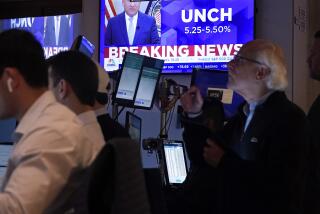Rally spurs belief bear market is over
With the Standard & Poor’s 500 index notching four straight winning weeks for the first time in more than a year, the stock market rally is gaining more believers.
July’s spikes in mutual fund redemptions, trading volume and key gauges of investor fear increasingly appear, in retrospect, to have been the “grand capitulation” that analysts had been awaiting to signal that the long bear market had run its course.
The chart pattern of major indexes in recent weeks -- an upward course of “higher highs and higher lows” -- looks bullish from a technical standpoint, analysts say: It shows that investors are less eager to sell on any advance and more willing to buy on any dip.
From its five-year low reached July 23, the S&P 500 has gained 16.4 percent. Small-and mid-cap stock indexes have posted more modest gains, but they weren’t as beaten down as blue chips at the July lows.
“I’m more optimistic than I’ve been in years. If we don’t get any climactic bad news, then we’ve seen the lows for some time,” said Bob Dickey, managing director at Minneapolis brokerage RBC Dain Rauscher. “I think we’re back to making money in the market, just not at the pace of the late 1990s. That was a bubble we’ll probably never see again.”
The recent trend of sharp gains late in the trading session also is a positive sign, Dickey said. It suggests rising confidence among short-term market players.
Analysts were encouraged by last week’s trading, which saw stocks fade Tuesday after the Federal Reserve warned of the risk of an economic slowdown, but then storm back Wednesday as the deadline for corporate chiefs to certify their companies’ financial results passed with few surprises. The S&P 500 gained 2.2% for the week, while the Nasdaq composite jumped 4.2%.
“In a sense, the market has reacted to itself,” said Don Cassidy, senior research analyst at fund tracker Lipper Inc. in Denver. “It didn’t get too discouraged about the Fed release, and people started saying, ‘Hmm, maybe I’ll buy a little more stock.’ ”
Cassidy said July’s net outflow from stock mutual funds, which Lipper expects to have exceeded last September’s record $30 billion when results are reported later this month, looks in retrospect like the kind of “panic selling” that often accompanies a market bottom. He said even conservative fund categories had net outflows (that is, redemptions exceeding new money invested).
“I think we had the grand capitulation that everyone has been looking for,” Cassidy said.
Stock fund outflows have continued in August, but at a far slower pace, said AMG Data Services of Arcata, Calif., which makes weekly estimates.
Another gauge of investor sentiment, the VIX index, which measures investor fear levels by tracking purchases of blue-chip stock “put” and “call” options, reached its most bearish point of the year July 23.
In the past, the VIX often has spiked at market bottoms as fear reached a peak.
Meanwhile, despite paltry yields, $2.3 trillion sits in money market mutual funds, and trillions more are in low-yielding bank savings accounts. Analysts say that if even a small portion of that cash enters the market, it could fuel a rally.
Despite the encouraging signs, the market faces risks from several directions, Dickey and others warn. If the U.S. economy slips back into recession or investor confidence is jolted again by corporate scandal, war or renewed terrorism, the market easily could head down in a hurry, they say.
Although the Fed signaled that it stands poised to cut rates again if needed to thwart recession, skeptics note that rates already are at 40-year lows.
It isn’t clear how much more help the economy would get from lower rates.
Stock valuations remain steeper than usual for a bear market bottom: By many estimates, the S&P 500 trades for about 18 to 20 times estimated 2002 operating earnings.
Historians also note that since 1971, September has been the weakest month, on average, for all three major U.S. indexes -- the Dow Jones Industrial Average, the S&P 500 and the Nasdaq composite.
“Traders coming back from the end of summer vacation often tend to clean house,” said Jeffrey Hirsch, publisher of the Stock Trader’s Almanac in Old Tappan, N.J. Also, Hirsch said, quarterly adjustments by mutual funds -- also known as portfolio “window dressing” -- add selling pressure as money managers unload losing stocks before Sept. 30.
Seasonal weakness could set the stage for a retest of the July 23 market lows, Hirsch said.
“I’m getting pretty bullish, but we’re not rushing in,” he said. “I’d feel much more confident after we get through September.”
More immediately, stocks may begin to meet what market technicians call “overhead resistance.” That’s when investors who bought shares at higher prices begin to see a rally as a chance to exit.
The mentality, Dickey said, is that a rebound is an opportunity to cut one’s losses.
For the Dow, which fell 40.08 points Friday to 8,778.06 but added 0.4% for the week, resistance is in the 8,800 range, he said.
Though the Dow could face a choppy ride in the near term, Dickey said he expects it to break through 8,800 and surge to about 9,500 in the next month or two.
Although July 23 might prove to be the low of the bear market that began in March 2000, Hirsch cautions that trying to pinpoint market bottoms can be hard.
In 1974, for example, at the end of a similarly brutal bear market, stocks appeared to hit bottom in October, but the Dow’s actual low came Dec. 6, he said.
“Only two kinds of people can call the exact bottom -- a liar or someone who gets lucky.”
More to Read
Go beyond the scoreboard
Get the latest on L.A.'s teams in the daily Sports Report newsletter.
You may occasionally receive promotional content from the Los Angeles Times.










